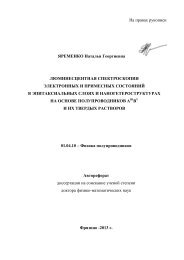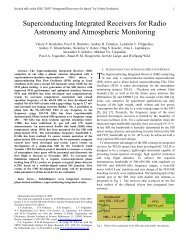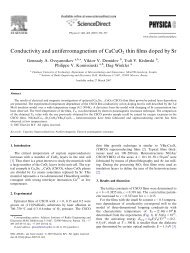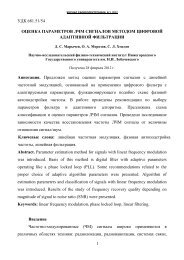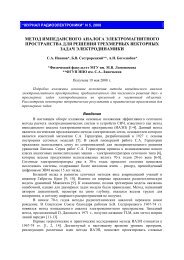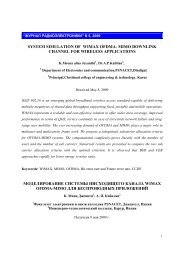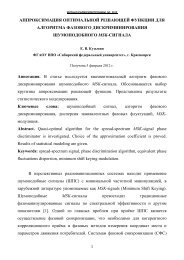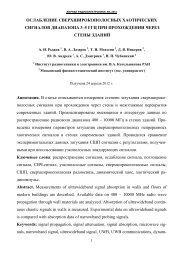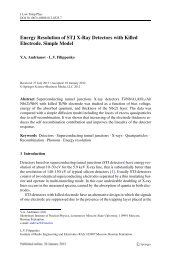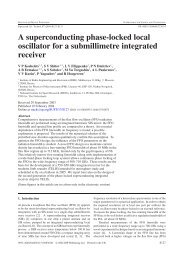Quench-induced trapping of magnetic flux in annular Josephson ...
Quench-induced trapping of magnetic flux in annular Josephson ...
Quench-induced trapping of magnetic flux in annular Josephson ...
Create successful ePaper yourself
Turn your PDF publications into a flip-book with our unique Google optimized e-Paper software.
<strong>flux</strong>ons created dur<strong>in</strong>g the quench, will be trapped <strong>in</strong> the junction until it is reheated, because<br />
<strong>of</strong> the Meissner effect <strong>of</strong> the superconduct<strong>in</strong>g annuli. This is schematically illustrated <strong>in</strong> figure<br />
1(a).<br />
(a) Simplified illustration <strong>of</strong> a trapped <strong>flux</strong>on <strong>in</strong> an<br />
<strong>annular</strong> <strong>Josephson</strong> tunnel junction. It is seen that<br />
the <strong>magnetic</strong> <strong>flux</strong> loop threads only one <strong>of</strong> the r<strong>in</strong>gs.<br />
(b) Actual geometry <strong>of</strong> <strong>annular</strong> <strong>Josephson</strong> tunnel<br />
junction no. 4, designated JJ4. The geometry <strong>of</strong><br />
no. 3 (JJ3) is similar, only the ground plane is<br />
without circular hole.<br />
Figure 1. Model and real geometry <strong>of</strong> the <strong>annular</strong> <strong>Josephson</strong> junctions. In both cases, the<br />
perpendicular dimension is exagerated.<br />
The creation <strong>of</strong> an <strong>flux</strong>on, and thereby a closed, oriented <strong>magnetic</strong> loop, <strong>in</strong>to the system is<br />
an example <strong>of</strong> a spontaneous symmetry break<strong>in</strong>g event; the perpendicular up-down symmetry<br />
<strong>of</strong> the system is broken by the directionality <strong>of</strong> the B-field. A key po<strong>in</strong>t to make is that the<br />
symmetry-break<strong>in</strong>g mechanism itself (ie. the cool<strong>in</strong>g) is symmetrical, and thus is not the direct<br />
cause <strong>of</strong> the break <strong>in</strong> symmetry.<br />
2. Theory<br />
An idealised model was proposed <strong>in</strong> 2000 [4] to test the KZ scenario for <strong>annular</strong> JTJs, assum<strong>in</strong>g<br />
that causal horizons are constra<strong>in</strong>ed only by the velocity <strong>of</strong> electro<strong>magnetic</strong> waves <strong>in</strong> the junction,<br />
the Swihart velocity [5, 6]. As a result, the probability f 1 for spontaneously produc<strong>in</strong>g one<br />
<strong>flux</strong>on <strong>in</strong> the thermal quench <strong>of</strong> a symmetric <strong>annular</strong> <strong>Josephson</strong> junction <strong>of</strong> circumference C was<br />
predicted to scale with the quench time τ Q (the <strong>in</strong>verse quench rate) as<br />
f 1 ≃ C¯ξ = C ξ 0<br />
( τQ<br />
τ 0<br />
) −σ<br />
, (1)<br />
where the scal<strong>in</strong>g exponent σ depends on the system. In Eq.(1), ¯ξ is the Kibble-Zurek causal<br />
length, the correlation length <strong>of</strong> the relative <strong>Josephson</strong> phase angle at the time <strong>of</strong> defect<br />
formation. The relative <strong>Josephson</strong> phase angle is the space-dependent difference <strong>in</strong> phase<br />
between the superconduct<strong>in</strong>g wavefunctions <strong>of</strong> the two r<strong>in</strong>gs mak<strong>in</strong>g up the <strong>annular</strong> josephson<br />
junction. The <strong>trapp<strong>in</strong>g</strong> probability is def<strong>in</strong>ed through Eq.(1) <strong>in</strong> terms <strong>of</strong> the zero-temperature<br />
correlation length ξ 0 , the relaxation time τ 0 <strong>of</strong> the long wavelength modes <strong>of</strong> the superconduct<strong>in</strong>g<br />
wavefunction, and the quench time τ Q , <strong>in</strong> turn def<strong>in</strong>ed by: T C /τ Q = −(dT/dt) T =TC . Eq.(1)<br />
holds for C < ¯ξ, where ¯ξ is the frozen-<strong>in</strong> correlation length, roughly equivalent to the size <strong>of</strong><br />
fluctuations <strong>in</strong> the superconduct<strong>in</strong>g wavefunction at the time <strong>of</strong> freez<strong>in</strong>g. The probability f 1<br />
is the sum <strong>of</strong> the probabilities <strong>of</strong> all the different ways <strong>of</strong> thread<strong>in</strong>g the geometry by a closed<br />
<strong>magnetic</strong> field loop, <strong>in</strong> such a way, that the field loop <strong>in</strong>tersects the tunnel barrier oxide just<br />
once, regardless <strong>of</strong> direction.



